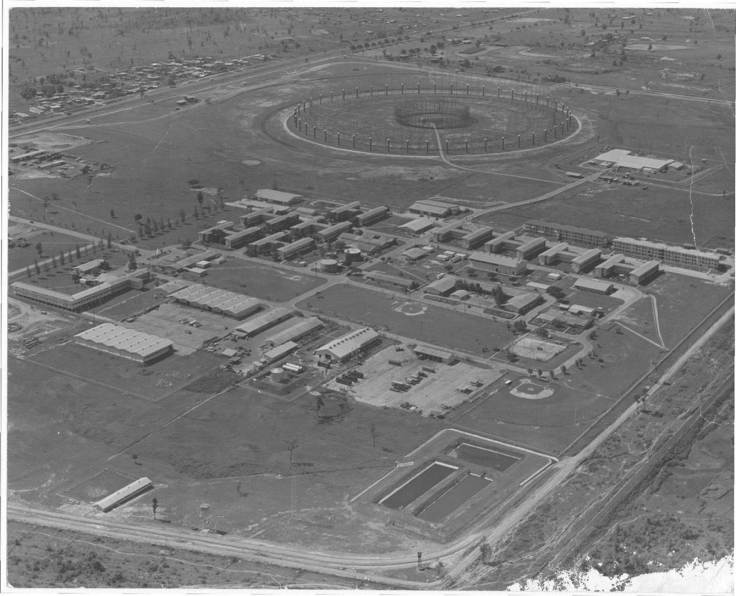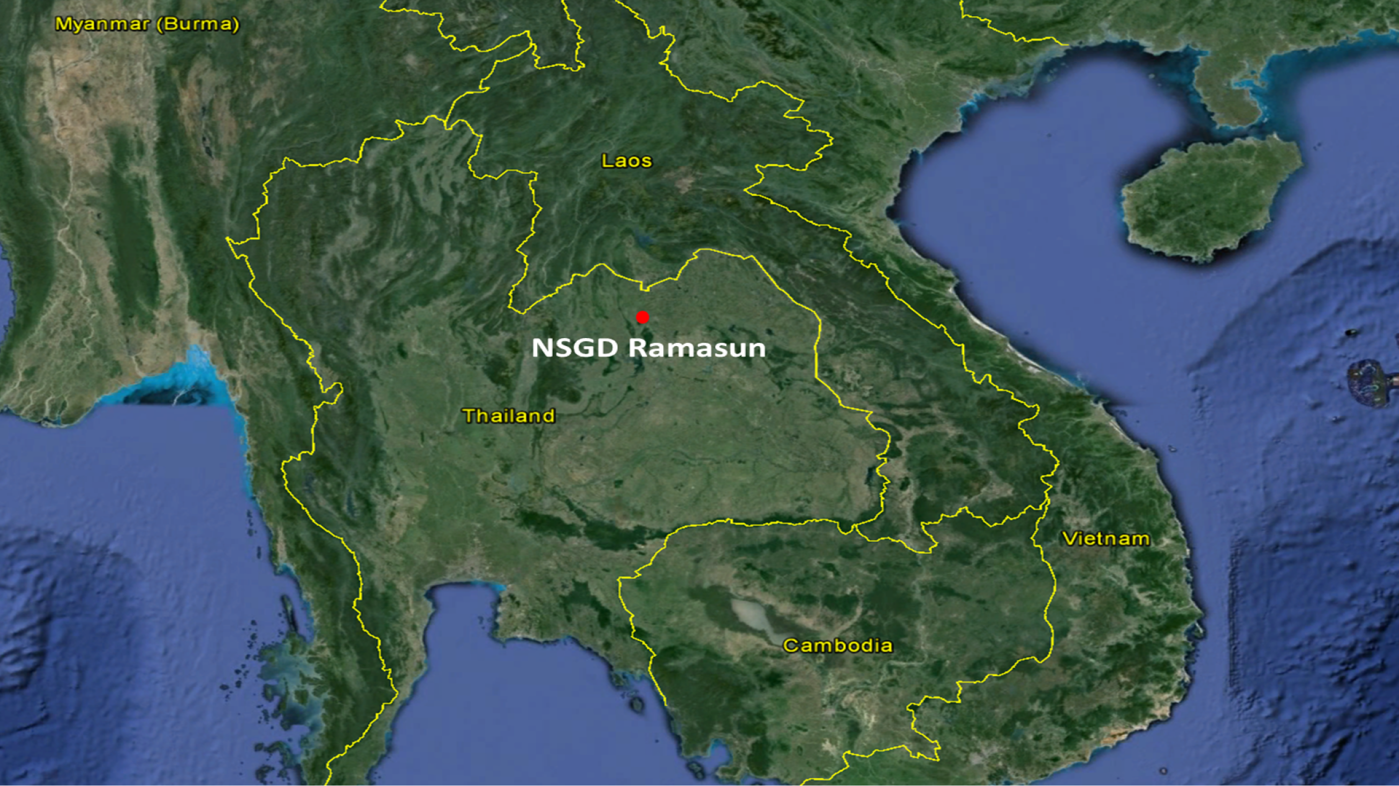U.S. Naval Security Group Detachment was established at Ramasun Station, Thailand in January, 1971.
The Vietnam War was the reason the Ramasun Station existed. Once the U.S. pulled out of Vietnam, the Ramasun Station site was no longer required and in May 1976 Ramasun Station closed. At the request of the Government of Thailand all U.S. units departed.
Background and History:
Ramasun Station’s history began in 1966 when a 50 man Detachment from the U.S. Army’s 5th Radio Research Unit (5th RRU) in Bangkok Thailand established a temporary outpost at Ramasun. Camp Ramasun was located approximately 290 miles northeast of Bangkok, about 12 miles south of Udorn and at the fringes of the small Thai village of Ban Nong Soong. Udorn was the site of the Royal Thai Air Force Base (RTAFB). The U.S. Army maintained a Satellite Communications Station at the U-Tapao Royal Thai Navy Airbase (the home of the B-52’s, KC-135’s, and U-2’s during the Vietnam War). Pattaya Beach, a very simple fishing village with 3 hotels was located near U-Tapao where military personnel from all over southeast Asia took R&R.

An AN/FLR-9 Circularly Disposed Antenna Array (CDAA), also known as Wullenweber, system was installed by the U.S. Army in 1970, which supported the High Frequency Directing Finding mission. The AN/FLR-9 installation was constructed about 20 kilometers south of Udorn Thani on the eastern side of the highway to Khon Kaen. The AN/FLR-9 was decommissioned in 1975 and dismantled in 1976. Ramasun Station was also a listening post to monitor Chinese military movements as well as a military satellite terminal for communications between the United States and other sites in Southeast Asia countries. When construction began at Ramasun, bulldozers discovered and removed large nests of cobra in the process. The initial site, little more than a tent city, was given the callsign “Cobra-7.”
Over 1200 U.S. personnel were stationed at Ramasun Station and employed more than 1400 Thais.
U.S. Army units located at Camp Ramasun included: the 5th Radio Research Unit (5th RRU), the 5th Radio Research Unit, Detachment “D” (5th RRU Det Delta) (1965), the 7th Radio Research Field Station (7th RRFS), the 7th Radio Research Field Station “B” Company (7th RRFS Co B), the 207th Signal Company (207th SigCo), the 509th Army Security Agency (509th USASA), the 999th Signal Battalion (997th SigBatt) (1961-62).
U.S. Air force units located at Camp Ramasun include: the 6922nd Security Wing, Detachment 4 (6922nd SW Det 4), the 6922nd Security Squadron (6922nd SS), and the 6924th Security Squadron (6924th SS). The 6924th Security Squadron (USAFSS), which had been stationed at Da Nang AB, South Vietnam, during the war in Southeast Asia and was deactivated on May 15, 1976.
The 17th Space Surveillance Squadron radar station at Kho Kha was located a few miles south of Lampang in northern Thailand. Their primary mission was tracking People’s Republic of China missile launches and southerly launches from the Soviet Union during the 1970’s.
Over 50 million dollars was devoted to constructing Ramasun Station, one of the finest installations anywhere in the world. It was completely self-sufficient and included its own power plant and water supply. Virtually all facilities on the post were air-conditioned and of permanent construction. Streets and sidewalks were paved and fully lit at night.
Lawns were landscaped, well attended, and enhanced by a variety of plants and shrubbery.
Side note: The line-of-sight radio path to Udorn Air Base was surveyed before construction of Camp Ramasun and the outside plant engineers found that a tree at the Ramasun end was obstructing a clear shot. Cutting down the tree would have been a simple solution, but the contractor had to get local Buddhist monks to first remove phi’s (spirits) from the tree and move them to another tree in the vicinity.
Source: navycthistory.com


2 January 2020 at 11:22
Our team of spooks were at Phu Bai until January 1972 when we were helo’d to Ramasun. We left behind some very nice Vietnamese who worked at Phu Bai. They knew the end was near as we prepared to leave. The Mamasan and Papasan rushed as fast as their old legs could move with their little dog in their hands and reached us as we neared the helo’s. With tears in her eyes, the Mamasan gave the dog to my friend, CTRSN Marc Creech, saying that the Viet Cong would eat their dog. Seconds later the helo’s departed. The dog became the Ramasan mascot.
LikeLiked by 1 person
2 January 2020 at 15:34
My error in time. It was January 1973 when we were helo’d. Chief Durst, in Sept, our team was on the USS Biddle at the Battle of Piraz.
LikeLike
2 January 2020 at 11:36
Another interesting story, thank you.
Sent from my iPad
>
LikeLike
2 January 2020 at 14:09
The NSGD in Ramasun station in Thailand was in fact opened sometime Sept 1972. That is when NSGD in Phu Bai was closed and all Navy personnel were flown to Thailand on C-130 aircraft, not Helo’s. Would be more than happy to provide further information as needed. CTRCM Durst, USN,Retired
LikeLike
2 January 2020 at 14:31
Master Chief Durst, I would be interested reading information you have on Ramasun. Thank you, Mario Vulcano
LikeLike
3 January 2020 at 02:39
Mario, I’ve been on my computer looking at what I have on it … various pictures of Ramasun but they main photo you show already covers the photos I have. Wish I could be of more help. I thought I once had some paperwork on it but I haven’t found it! If I still have it, it’s probably boxed up (I live in an RV). You guys are doing a great job! Keep it up. Thanks //dusty durst
LikeLike
2 January 2020 at 14:39
Anyone been to the old site lately to see what’s left of it?
LikeLike
2 January 2020 at 16:55
We lived and loved it.
Lenny Carter
CTRCS Retired
LikeLike
2 January 2020 at 21:50
Great place! Real paradise
LikeLike
4 May 2021 at 20:11
Donf217@yahoo.com
What an experience! It was the right place at the right time. It was a pleasure working with you Lenny, and Leroy. I was there with my brother Jack. R Branchers….
Don Fuentes CTR
LikeLike
14 March 2022 at 08:45
Was apparently the first officer to serve there in 1975. Great memories from a group of 22 sailors who were top-notch. Most notable was our Navy birthday celebration in October. Thanks to CTRCS Glen Kruen (sp), we all wore different navy uniforms on Friday and capped it off with a fantastic Navy Ball on Saturday eve. It broke my heart when we closed the detachment in May of the following year.
LikeLike
28 July 2022 at 02:28
I originally had orders to Ramasun back in March 1976. However, I was assigned to U-Tapao for two weeks when the base was closed. I then received an assignment to the 6922nd Security Squadron at Clark AB, Philippines.
LikeLike
20 November 2022 at 04:08
Lots of stuff happened there that I don’t see mentioned after extensive research spanning several decades. I was stationed there either the entire year or part of the year from 1972-76. It was far more than anyone who wasn’t there could ever imagine. I’ve been back since and the Thai military there was gracious enough to allow me to tour the fascinating garrison area, but the area where the Cage and the Box were located was long since overgrown with jungle, and I was denied access to it. I would dearly love to research existing records — classified or not — from the infamous “Rock and Roll Freak Show” at Non Soong.
Dave Hamilton
Major, U.S.Army (Retired)
LikeLike
13 January 2023 at 01:50
Interesting article and comments. I was a SP4 at the Freak Show from July 73-Aug 74 as the clerk typist for Troop Command. Lot of changes during the year. A new building was built to house Troop Command and a few other offices. A new PX was built and a new club (huge party when the club opened). All the buildings are still standing if you look on Google Earth, except the “Box.” Even the Elaphant Cage (our label for the FLR 9) is visible on Google Earth – 17°17’37″N 102°52’05″E.
LikeLike
13 January 2023 at 02:00
Anyone there July 73-August 74, would enjoy hearing from you to see if we were friends at Ramasun.
LikeLike
20 January 2023 at 06:16
Anyone who served at Ramasun Station from 1972-76 may feel free to contact me on email to discuss some of the good old days there, if interested. Just give me an e-mail address here and I will be in touch.
LikeLike
5 October 2023 at 22:14
I was Miltary Police stationed at Peppergrinder ’72-’73 which was an ammo dump about 2 miles north of Ramasan. Ate meals there and had some good nights at the club. Outdoor movies were fun. Good people there. One of the enlisted men stationed there would play Jimmy Hendrix better than Hendrix did. Met a girl named Joy there. Lol. 50 years ago. We had no barracks at Peppergrinder so we lived at the Udorn Hotel and would hang at the Champagne Room.
I was 20. Stupid innocent kid who had no idea what work was being done there. I had volunteered for Nam but Nixon cut back troops to Nam so they diverted me to Thailand. Seems like yesterday.
Pfc William Lagnese
Rellik900@aol.com
LikeLike
19 January 2024 at 18:40
I still dream of Thailand. ASA, 05H20, 73-75.
LikeLike